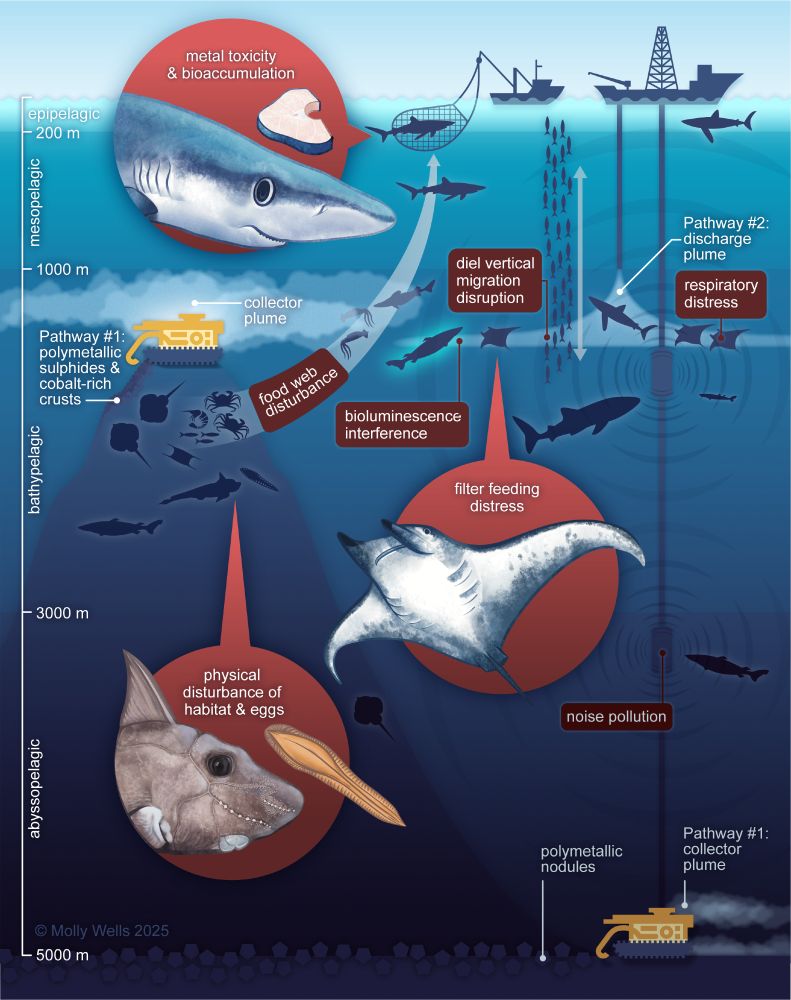
PhD student at UH Mānoa studying how marine biodiversity supports ecosystem functions and provisions to humanity.
Searching for new sharks, rays, and chimaeras🦈
He/Him 🇮🇳🇮🇹🏳️🌈🕎
1. Updates to ISA, IUCN, and other assessments incorporating the risks of mining to chondrichthyans.
2. Enhanced sampling and monitoring.
3. Spatial management tools to protect at-risk species.
4. A deeper discharge plume, but must assess biodiversity impacts and further risks

1. Updates to ISA, IUCN, and other assessments incorporating the risks of mining to chondrichthyans.
2. Enhanced sampling and monitoring.
3. Spatial management tools to protect at-risk species.
4. A deeper discharge plume, but must assess biodiversity impacts and further risks
1️⃣ Deeper than 2000 m where there is limited chondrichthyan overlap. But ecosystem impacts remain.
2️⃣ At the seafloor to limit pelagic disturbance BUT this will further threaten benthic biodiversity (inc. chondrichthyans, see sulphide mining - PMS)

1️⃣ Deeper than 2000 m where there is limited chondrichthyan overlap. But ecosystem impacts remain.
2️⃣ At the seafloor to limit pelagic disturbance BUT this will further threaten benthic biodiversity (inc. chondrichthyans, see sulphide mining - PMS)
🌊 25 species overlap directly with seabed impacts, 17 have > 50% of their depth range overlapping
🌊 All species overlap with discharge plume scenarios
🌊 The chocolate skate has a 75% depth overlap and is egg-laying and benthic (traits which elevate its vulnerability)

🌊 25 species overlap directly with seabed impacts, 17 have > 50% of their depth range overlapping
🌊 All species overlap with discharge plume scenarios
🌊 The chocolate skate has a 75% depth overlap and is egg-laying and benthic (traits which elevate its vulnerability)
🦈 Unique deep-sea species such as two chimaeras, the megamouth shark, great lanternshark, and cookiecutter shark
🦈 Deep divers such as devil and manta rays, the whale shark, and white shark
🦈 > 60% already threatened with extinction, 12-16 at-risk species per contractor

🦈 Unique deep-sea species such as two chimaeras, the megamouth shark, great lanternshark, and cookiecutter shark
🦈 Deep divers such as devil and manta rays, the whale shark, and white shark
🦈 > 60% already threatened with extinction, 12-16 at-risk species per contractor
🖼️Molly Wells

🖼️Molly Wells
🖼️ Miller et al. 2018

🖼️ Miller et al. 2018

